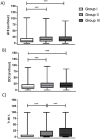Increase in the frequency of obstructive sleep apnea in elderly people
- PMID: 31890099
- PMCID: PMC6932834
- DOI: 10.5935/1984-0063.20190081
Increase in the frequency of obstructive sleep apnea in elderly people
Abstract
Background: The prevalence of obstructive sleep apnea (OSA) increases with age. However, older adults have limited perception of the symptoms related with poor sleep quality.
Objectives: To know the frequency and characteristics of age-related OSA in a large population with clinical suspicion of sleep apnea.
Methods: We conducted a retrospective study. OSA was studied by respiratory polygraphy (RP). Patients were grouped by age (G): GI was between 18-45; GII: 46-65 and GIII > 65 years old. Other demographic characteristics, symptoms and RP indicators were compared. Epworth Sleep Scale (ESS) was used to analyze symptoms.
Results: We included 2491 patients with sleep apnea symptoms. OSA frequency (AHI > 15) in each group was 33.2 % in GI; 45.8 in GII and 50.3 in GIII (p < 0.001). Despite the significant increase in OSA severity, GIII group reported fewer symptoms (ESS: 6.0; p < 0.001). Multivariate adjusted analysis showed that the odds ratio of having OSA is three times as high at age > 65 (OR: 3.32 (2.29 - 4.88) p < 0.001).
Conclusions: As in previous reports, OSA prevalence in our population was higher among the elderly. The early identification of this syndrome in a population with poor perception of symptoms would aid to improve patient management.
Keywords: Adult; Aged; Sleep Apnea Syndromes; Sleep Apnea, Obstructive.
Conflict of interest statement
8.3. Disclosure Statement The authors have no conflicts of interest to declare. 8.3. Disclosure Statement The authors have no conflicts of interest to declare.
Figures
References
-
- Cohen-Zion M, Stepnowsky C, Marler, Shochat T, Kripke DF, Ancoli-Israel S. Changes in cognitive function associated with sleep disordered breathing in older people. J Am Geriatr Soc. 2001;49(12):1622–1627. - PubMed
-
- Munoz R, Duran-Cantolla J, Martínez-Vila E, Gallego J, Rubio R, Aizpuru F, et al. Severe sleep apnea and risk of ischemic stroke in the elderly. Stroke. 2006;37(9):2317–2321. - PubMed
-
- Onen SH, Lesourd B, Ouchchane L, Lin JS, Dubray C, Gooneratne NS, et al. Occult nighttime hypertension in daytime normotensive older patients with obstructive sleep apnea. J Am Med Dir Assoc. 2012;13(8):752–756. - PubMed
LinkOut - more resources
Full Text Sources
Research Materials


